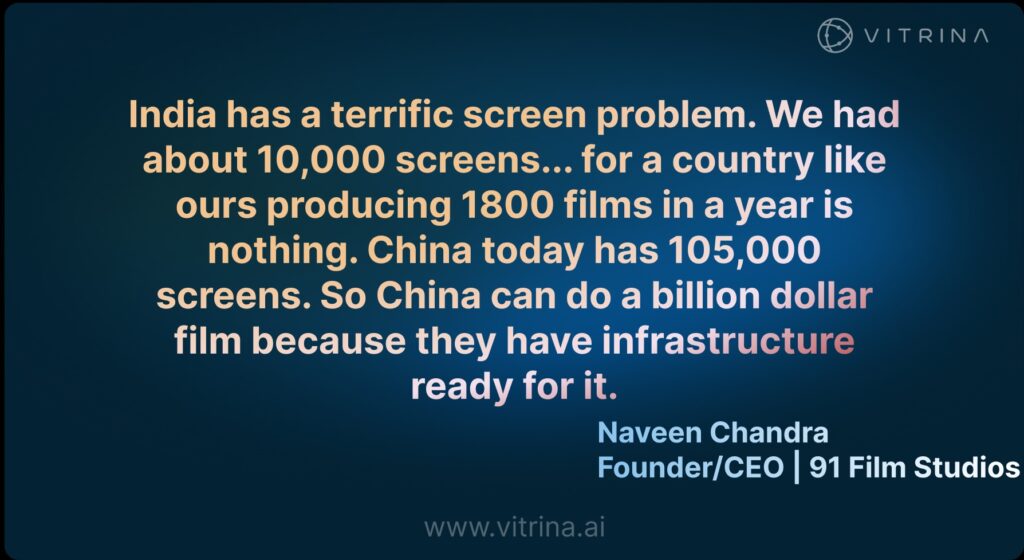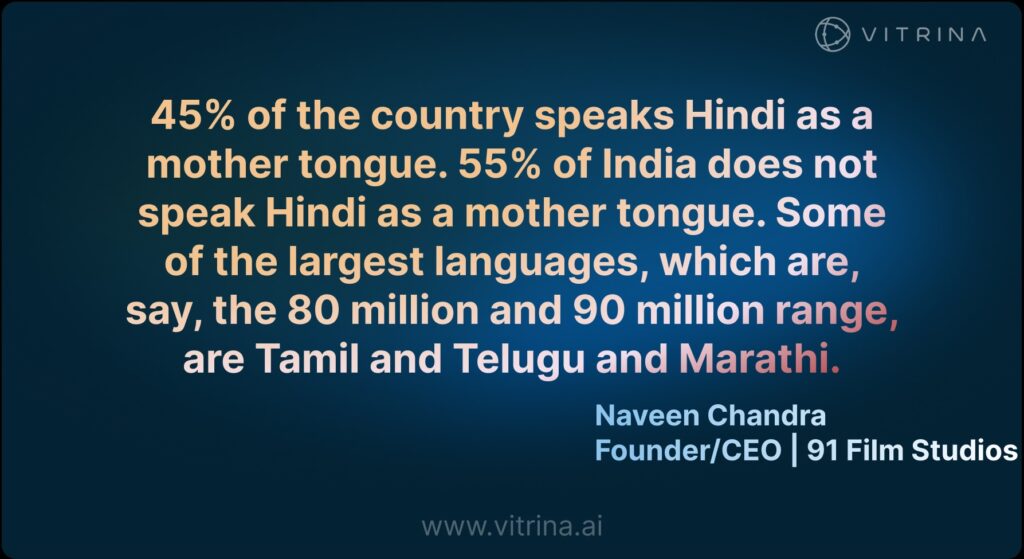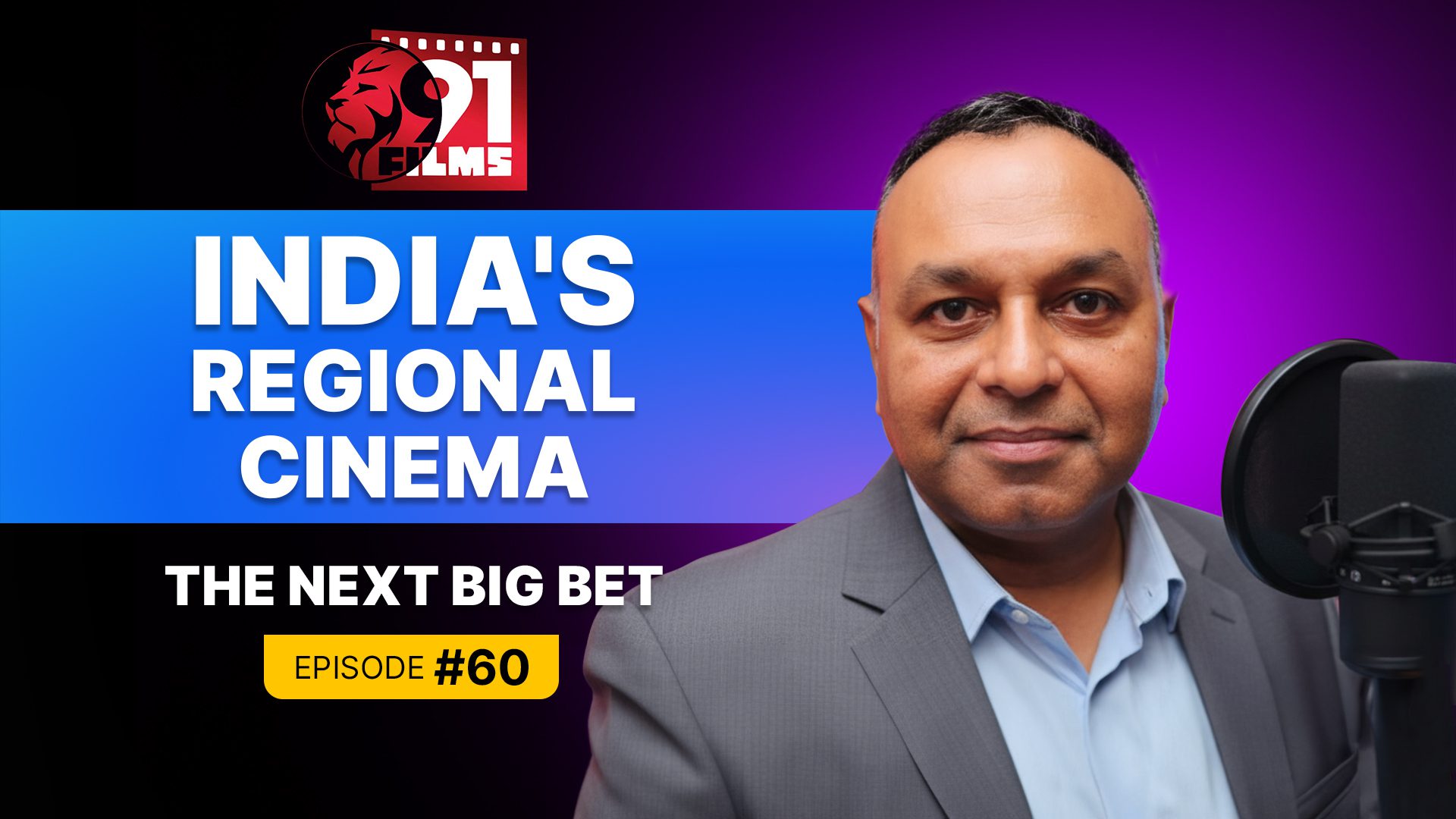This episode of LeaderSpeak features Naveen Chandra, CEO and Founder of 91 Film Studios, who discusses the founding philosophy of his organized capital fund for films, and the immense, yet often misunderstood, potential and business dynamics of India's regional cinema market.

Podcast Chapters
| TimeStamp | Chapter |
| 02:38 | The Media Man’s Pivot to Film |
| 09:00 | Strategy: Organized Capital and The Fund |
| 12:08 | Pandemic Advantage & Story Selection |
| 20:25 | The De-Risking Business Model |
| 32:51 | Regional Cinema’s Rise and Market Multipliers |
| 49:10 | Challenges in the Toughest Markets |
| 58:25 | Key Stats: The Regional Indian Film Industry |
| 1:03:52 | Future Roadmap: Value Over Volume |
Key Takeaways:
- Solving Industry Gaps: 91 Film Studios was founded to address critical deficiencies in Indian cinema: stalled film production (50% incomplete), lack of distribution (50% unreleased), and scarce organized capital for talent.
- De-Risked Investment Model: The studio uses an equity-only, “slate” investment model to manage risk. This strategy allows one low-budget regional blockbuster (like a Marathi film doing $15 million on a $0.5 million budget) to potentially cover the cost of the entire portfolio.
- Regional Dominance: Regional cinema is leading the market, growing from 20% to 60% of the box office top 10 collections between 2019 and the present. It provides better revenue multipliers (4x, 5x, up to 25x) and a focus on original stories compared to Bollywood.
- Universal Storytelling Success: Industries like Malayalam and Punjabi are successful because they focus on universal stories that travel internationally. Malayalam films compete with Hollywood in the Middle East and often skip traditional songs or heroines, while Punjabi films get up to 50% of revenue from international markets like Canada and the US.
- Toughest Market Challenges: The Marathi market is identified as the most stressful and complex due to the state’s cultural fragmentation, requiring filmmakers to carefully manage budgets to match the restricted distribution appeal of specific regional stories.

Sound Bites:
- “50% of the films that get out to get made don’t get completed. 50% of the films that got completed did not get distributed.”
- “The key part about the film is always the IP, because the IP is the perpetual value in the film.”
- “I always have a co-producer model because I always say that films is the most risky business… So equal risk, equal rewards.”
- “If you are willing to climb below the one feet of subtitles at the bottom, there is great content you can discover.”
- “Regional film returns have also started matching and beating scale of Bollywood films. They Beed the multipliers.”
Projects Mentioned in the Podcast
Roja (Tamil), Bombay (Tamil), Minnal Murali (Malayalam), Lokah (Malayalam), Baipan Bhari Deva (Marathi), Love Today (Tamil), Dashavatar (Marathi), Parasite (Korean), Bahubali (Telugu/Hindi), R R R (Telugu/Hindi), Aavesham (Malayalam), Manjummel Boys (Malayalam), and Romancham (Malayalam).
Why Partner With 91 Film Studios?
- Exploit Regional Market Multipliers: Partner with a studio that targets the high-growth regional market, which offers profit multipliers of 4x to 25x, significantly outperforming Bollywood’s returns.
- Access De-Risked Capital Pools: The fund strategy uses a diversified slate of low-budget films ($0.5 million target) where one hit can financially cover the entire portfolio, significantly lowering investor risk.
- Gain Perpetual IP Value: The studio focuses on owning the Intellectual Property (IP), ensuring continuous monetization through remakes (Bollywood, Hollywood) and long-term satellite/digital rights.
- Vetted, High-Quality Story Flow: Benefit from a disciplined system for story acquisition, created to solve the market’s chronic funding gap for quality, original narratives and talent.
- Focus on B2C Theatrical Success: The studio is dedicated to B2C theatrical films, viewing them as creator-owned products, ensuring maximum box office returns before digital and satellite monetization.
In Conversation with Naveen Chandra, founder & CEO at 91 Film Studios
This is a written summary of the “Leader Speak” podcast episode featuring Navin Chandra, CEO and Founder of 91 Film Studios. The conversation has been restructured into a quick-read Q&A format, highlighting the most insightful points about the business of Indian regional cinema.
🎤 Leader Speak: Q&A with Naveen Chandra, CEO of 91 Film Studios
1. Vitrina: How did you transition from a media and broadcasting background (Radio Mirchi, Gaana.com, ET Now, Movies Now) to founding 91 Film Studios, and what is your company’s core business model?
Naveen Chandra: My career covered print, radio, television, and digital, making films the only missing piece in my media portfolio. I realized I needed a personal strategy after winning the Michael Porter Prize. After meeting many people in the film business, I identified three key needs in the market: 50% of films started don’t get completed, 50% of completed films don’t get distributed, and great talent struggles to find funding. The solution was to create an organized capital pool, leading to the idea of a fund, initially structured as the Storytellers Fund, a Category II Alternate Investment Fund (AIF). My core focus is on regional cinema, and my principle for funding is to use only equity, never debt. I always use a co-producer model to share risk and spoils equally, and I take capital for a slate of films rather than a single project to de-risk the investment.
“50% of the films that get out to get made don’t get completed … 50% of the films that got completed did not get distributed … and a lot of talent out there that doesn’t know where to go for money. So I said, therefore the solution to this, and that’s the need, is to create an organized capital pool.”
2. Vitrina: Why did you choose to focus exclusively on regional cinema, explicitly excluding Hindi cinema, and what was the insight behind your 2020 prediction that this decade would belong to the regional market?
Naveen Chandra: I chose to exclude Hindi cinema because it is a language everybody does, and there is already a way in Hindi/Bollywood to raise capital. My focus is sharply regional. I wrote an article in January 2020 predicting that this decade would be the decade of regional cinema. The big insight is demographic: 55% of India does not speak Hindi as a mother tongue. Furthermore, regional films are currently outperforming: in 2019, regional films made up 20% of the top 10 box office, but as of Jan-Sep of this year, that share is 60%. Regionals are now often matching and beating the scale of Bollywood films and producing better multipliers (4x, 5x, 25x).
“In 2019, regional films were only 20 % of the box office… And now top 10 is 60 % of the box office.”
3. Vitrina: How did the pandemic impact your business, and what is the current state of recovery for Indian cinema box office?
Naveen Chandra: The pandemic created an initial standstill, but it turned into a “godsend gift” for story acquisition. Before the pandemic, a team had to fly down from different cities for a story pitch, but Zoom enabled us to listen to 300 stories in three months with discipline. The pandemic created a glut of films that were unsold and could not get a theatrical release, leading to massive stress on the system. However, the Indian box office has fully recovered: the collections from January to September of this year are equal to the highest-ever collections for the same period in 2019.
“Before the pandemic, if I wanted to listen to a Tamil story, we had to fly the director down… On the other hand on Zoom… we finished 300 stories in three months. With discipline, with rigor, no Saturday, no Sunday, every single day we just listen to stories.”
4. Vitrina: Can you break down the overall Indian film industry market size and the relative share and growth rates of the key regional languages?
Naveen Chandra: The total size of the Indian film industry is roughly 19,000 to 20,000 crores (around 200,000 million). Hindi box office accounts for about 3,500 to 4,000 crores (35,000 to 40,000 million). Regional cinema is around 7,000 to 7,500 crores (70,000 to 75,000 million). Of this, Tamil and Telugu account for about 6,000 crores (60,000 million), and Malayalam is roughly 1,000 crores (10 million). The South states, particularly Tamil and Telugu, are growing faster than India’s overall GDP growth, leading to more disposable income and spending on movie tickets. Tamil and Telugu top the list in terms of screens and movie-going populace.
“If you look at India’s GDP growth… the South states are growing faster than the GDP growth of the country.”
5. Vitrina: Malayalam cinema is often praised internationally. How does it manage to achieve such high box office returns with a relatively small native speaking population?
Naveen Chandra: Malayalam is a unique case, with only 35 million native speakers. Despite the small local market, it has the highest bang for the buck, with movies doing amazing multiples relative to the population. This is achieved because Malayalam stories are “universal,” having managed to crack the Hollywood formula of universal storytelling. They focus on story, often excluding songs and even heroines (some recent films had no heroine). In international markets like the Middle East, Malayalam competes only with Hollywood for footfalls, not even Hindi.
“I think the singular thing that they managed to achieve is make their story, make their stories travel outside the state. Malayalam stories have managed to crack the Hollywood formula of universal storytelling.”
6. Vitrina: What is the financial rationale behind your fund model of investing $0.5 million per film, and how does the monetization for regional films compare between box office and streaming?
Naveen Chandra: My core principle is not to exceed half a million dollars (USD 500,000) for any single film. The math is simple: if you put in $15 million and can make 30 films at $0.5 million each, even if one film does $15 million at the box office (like Baipan Bhari Deva or Love Today), you have already gotten your money back. The key is de-risking by investing in a slate, which is a distinct possibility. For regional films, box office (e.g., $15 million) is one component. Satellite and digital rights vary completely and are purely driven by demand and supply, with no fixed formula.
“If you put in $15 million and half a million dollars to make 30 films. So even if one film does $15 million, you got your money back … I mean, it’s a distinct possibility.”
7. Vitrina: Which regional market do you find the most stressful or challenging from a business perspective?
Naveen Chandra: Generally, Marathi films tend to be the most stressful. This is due to a lack of homogeneity, with, what I call, five different Maharashtras. The film needs a story that can travel through all these different pockets (e.g., Mumbai/Pune vs. Kolhapur/Sholapur vs. Nagpur). If a film is only made for one-fourth of the territory, the cost must be one-fourth to get a return. If you make a Hindi film in Marathi, it will not last because people can see a better-produced Hindi film; Marathi audiences want to connect to their roots and culture. However, films on Chhatrapati Shivaji Maharaj are a guaranteed box office. Bengali is also a very stressful market, struggling to get a return at the box office, requiring very low budgets and very short production timelines.
“The only Marathi film that was not stressful was the one that I did on Shivaji… Chhatrapati Shivaji Maharaj is our avenger. India’s avenger. You are guaranteed box office. There is nothing that can go wrong.”
8. Vitrina: What is your current roadmap, and what defines success for 91 Film Studios?
Naveen Chandra: The pursuit of regional cinema continues, as I believe films are a B2C product, unlike OTT/TV, which are B2B. Regional cinema is my theme because it provides original stories, allows content creation at a lower price point with box office success, and I own the IP for exploitation in multiple languages. My immediate slate includes a Marathi film releasing by the end of this year, a Telugu film under production, a recently finished Tamil film, and a Bengali film going into production next year. The long-term destination is to build back the initial target of a $25 million fund. Success is defined by value, not volume, as movies are not a volume business.
“I believe regional always gives original stories … I can make content at a far lesser price point, make it work at the box office and I own the IP so I can always exploit it in multiple languages.”
——————————————————————————————————————————–
Capitalizing on Regional Cinema: 91 Film Studios
91 Film Studios, founded by Naveen Chandra, is a specialized film production and distribution company. It was created to address the lack of organized capital in the Indian film industry. The studio follows an equity-only, de-risked approach by investing in a slate of low-budget regional films , aiming to unlock the high-return potential and intellectual property value of Indian regional language content.





 Mumbai, India
Mumbai, India




